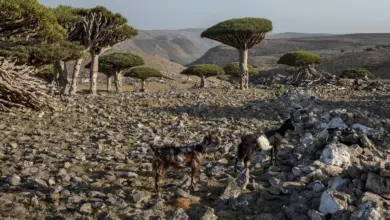Bedouins in the quiet Sinai city of Nuweiba managed to stop the construction of a power plant, in what is regarded as a rise in environmental awareness in Sinai.
The story began when local residents of Nuweiba noticed an increase in construction equipment around their city early last year. They inquired into the matter and learned that a 750 megawatt power plant was to be built near the city center. Tensions rose quickly, followed by quarrels. Then the police arrived and the Bedouins were silenced.
But soon after that, something happened: Nuweiba locals developed their own environmental campaign. Theirs is just one of a number of ongoing campaigns attempting to stand up to environmentally destructive projects and the policies that drive them.
In the case of Nuweiba, the campaign first materialized when knowledge of the impending power plant reached a man by the name of Sherif el-Ghamrawy, best known as the owner of the ecolodge Basata, just north of Nuweiba.
According to el-Ghamrawy, it soon became apparent that the documents permitting the construction of the power plant had been issued by the South Sinai Governorate, and had not been officially approved by the Environment Ministry.
“When I found out about this situation,” says el-Ghamrawy, “I said wait, let’s take the right steps. Who is behind this?”
The plant was to receive funding from the African Development Bank and European Investment Bank, both working with the Egyptian Electricity Holding Company (EEHC) to carry out the project. El-Ghamrawy quickly sent a letter of complaint to both banks, explaining that their funding would have a serious impact on tourism and the environment in the area. He soon found himself being addressed as a representative of the entire local community.
El-Ghamrawy met with anxious Bedouins and requested that their protests remain civil. “No violence, no demonstrations,” he said. Together, along with the chamber of hotels and the diving chamber, and numerous tourism and commercial organizations, they began a reasoned mediation process with the two banks and the EEHC.
The campaign had two main concerns. One was the environment. According to the Hurghada Environmental Protection and Conservation Association (HEPCA), as well as el-Ghamrawy, the plant would need to consume 1.3 million cubic meters of water from the sea per day in order to function, pumping it back at temperatures between 5°C and 9°C warmer. (Click here for HEPCA’s initial report on the power plant.)
"The amount of discharged water into the Red Sea, plus the impact of building on the coastline, is criminal, given that the entire place is promoted as an eco-destination," said HEPCA’s managing director, Amr Ali.
The impact on tourism and the local community is the campaign’s second concern. El-Ghamrawy believes that when it comes to Sinai, the EEHC and other government bodies are largely concerned with tourism figures solely coming from Sharm el-Sheikh. “But,” says el-Ghamrawy, “tourism in Nuweiba and Sharm are completely different. One is based on eco-tourism, the other on mass tourism.”
Moreover, the EEHC hoped to argue its case for the location by saying that it would help create jobs for Bedouins. “Again,” says el-Ghamrawy, “the EEHC could not appreciate that Bedouins never work in construction or labor–they’ve always worked in tourism or something related. In reality, this plant would have only attracted workers from the New Valley, while pushing the Bedouins back to the mountains.”
Perhaps the fact most neglected by the EEHC, and initial assessment reports, is that the entire Gulf of Aqaba is supposed to be a protected area. “There is no industrial zone in Nuweiba as some have claimed,” says el-Ghamrawy, “the plant was going to be built just 200 meters from commercial shops.”
For Amr Ali, this all pointed to one thing: “For the Electricity Ministry, environmental compliance is still seen as a luxury, not a necessity.”
Nevertheless, after the campaign presented these arguments to the banks, the European Investment Bank sent three independent experts to assess the situation in October 2009. Though the EEHC has not released the reports, an email sent to the campaign directly from the bank confirmed that the project will have negative social and environmental effects if the location is not changed.
In turn, HEPCA reported in its newsletter on 1 January, 2010 that "the European Investment Bank has declined a US$320 million loan to finance the project amid considerable pressure from environmental campaigners.”
According to el-Ghamrawy, the success of the campaign marked a new kind of activism in Egypt, getting things done in an entirely legal, civil, and reasoned manner. “What we took most from this campaign was how the whole society came together, as one front, including the two Bedouin tribes inhabiting the area, the Tarabin and Maizena, who have a history of feuds,” el-Ghamrawy says.
For now, it is presumed that a search is underway for a new location of the power plant. But, as HEPCA warns in the conclusion of its newsletter, “Environmental campaigners will be watching closely what is proposed in the future.”
Stay tuned for a series of articles, in which Al-Masry Al-Youm will take an in-depth look at a number of other recent cases where environmental activism proved itself to be more than an easily disregarded whimper.




